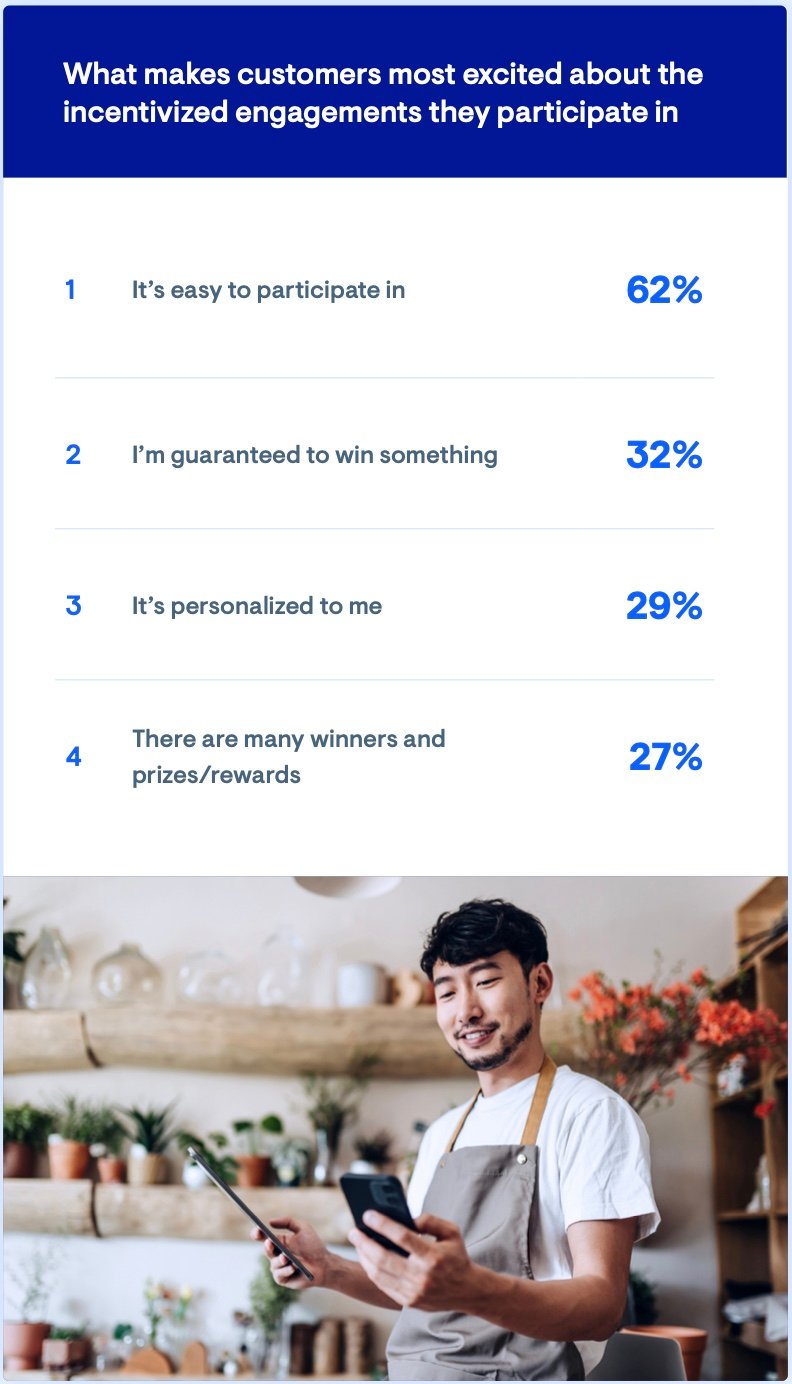The usual approaches to customer loyalty are changing for U.S. brands and retailers, and for brick-and-mortar stores, many factors are at play. As inflation remains a threat, price sensitivity is turning customers toward bargain-hunting. Brand-switching is the norm. And the conveniences of e-commerce are still a strong draw.
According to an ebbo™ study, 78% of the 2,500 consumers surveyed belong to a loyalty program. While conventional wisdom might convince retailers that a loyalty program featuring reward points and discounts is table stakes and does help retain customers, in a constantly evolving retail marketplace, there must be more to the story than that.
There is. Improving customer loyalty is a must if retailers and brands want to strengthen customer engagement, retain customers, and outpace the competition.
So, what are the key factors of an ideal customer loyalty program? Here’s a rundown of the kinds of objectives your loyalty program should entail.
Make Incentives Truly Motivational
The ways brands and retailers can incent repeat purchases are limited only by the imagination. Discount codes, sweepstakes, and referral bonuses can be quite successful. However, they must be meaningful to customers. For instance, the ebbo study found that 78% of consumers would refer a brand’s loyalty program to friends and/or family in exchange for an incentive.

Source: ebbo
Enhance Employee + Customer Interactions
Preparing employees to assist customers efficiently and effectively is essential. Employees who serve customers in a way that is helpful and leads them toward a satisfying purchase decision can leave a lasting and positive impression.
This means employees must have access to real-time customer insights, as well as information on product supply, shipments, and inventory. They must be aware of current promotions and discounts so they can offer them to eligible customers.
Allow employees to use technology that enhances the customer experience and consolidates various communication channels so that important information is easily shared, interpreted, and updated – both between employees and customers and between employees and store management.
A sales associate who can confidently communicate with shoppers is creating value by showing they care about customers and are proud of their brand.
Keep Your Loyalty Strategy Fresh
A loyalty strategy isn’t something that is fixed in stone for life. Rather, it should continually be re-examined as to its relevancy and results. As we’ve seen, cultural, behavior, and economic shifts can happen suddenly, so being nimble is essential.
Keep your finger on the pulse of customer preferences, expenditures, and response rates. Can you do a better job of segmenting consumers to fine-tune promotional targeting? How well are you maintaining a customer-centric focus? Are there retention opportunity gaps?
Ensure you are taking advantage of every potential customer touchpoint and communication channel to optimize your loyalty program. Be willing to admit it when a tactic fails, and quickly replace it with one that you believe will work better. Consider upgrading your tech stack to improve efficiency and ensure your consumer behavior analytics are optimized to fit your business model and to capture the right kind of data at the right time.
As the ebbo study advises,
“As customers become more selective with their spending and prioritize bang-for-buck, differentiation and value are how brands will continue to retain their valuable customer bases and minimize loss.”
Create an Emotional Customer Connection Based on Trust and Personalization
A recent Salesforce study found that 88% of customers believe trust is more important in times of change. Developing customer trust is a multi-faceted process. And, just as trust is built between individuals, it will occur naturally if you keep your promises, offer transparency, admit when you make a mistake, and maintain the confidentiality of private data.
The same study found that 73% of customers expect companies to understand their unique needs and expectations. To do this demands brands and retailers know as much as they can about their customers, which starts with collecting and tracking data on shopping patterns and purchase preferences – inclusive of both online browsing and in-store visits. And then, communicating with customers in a way that shows you understand who they are, are relevant, and value their being a part of your brand’s fan base.
Once these two aspects are in place, you’re on the right path. Why? The Salesforce survey found that 63% of customers say they feel an emotional connection with the brands they buy from the most. Instill that emotional investment by thanking and congratulating them on their latest purchase. Suggest ways they might want to accessorize a product or buy the same or similar one as a gift for a friend. Incentivize repeat purchases with exclusive offers and rewards that are adjusted to suit the individual’s shopping history.
Reward Customers for Activities Outside of Purchases
Heavy competition for the customer’s dollar means brands and retailers should be rewarding customers for other reasons than buying a product. There are so many ways customers can engage with brands that retailers should be proactive in acknowledging those engagements.
For instance, customers may be reading your blog or commenting on a social post, or visiting your YouTube channel. After they view a brand video, you could invite them to post comments. Request a review of a purchase experience. Ask customers to upload an image showing them wearing or using your product. Invite them to answer short surveys. Then, reward them with a discount on their next purchase or enter them into a sweepstakes drawing.
Research shows that family and friends’ positive recommendations also have a huge impact on brand loyalty. Encouraging customers to post honest endorsements turns them into brand advocates and increases your chances of acquiring new customers.
Be Bold in Sharing Your World View
Increasingly, shoppers are becoming more aware of a brand’s stance on issues they care about. They will often make a purchase decision based on the company’s beliefs and, even more important, they seek to do business with brands whose commitments align with their interests and values.
Share some of the ways your company is making a difference in the world or contributing to charitable causes so that customers will exude pride in associating with your brand. That pride may even translate into public praises on social media. Be sure you’re monitoring for those mentions and reply timely and sincerely.
If your brand supports a cause, or your products are manufactured in ways that make a positive difference in the world, shout it out from the rafters. Make an effort to bring customers to a full understanding of your ethos. Promote your social actions, the charitable contributions you make, and the volunteer activities you are involved in. Then, assure your values translate into action, and transform actions into potential engagement opportunities for customers. Customers who relate to your beliefs and actions as a part of the wider world will stay with you.
In a report on customer transformation, PwC observes,” This is where you can create new social contracts—becoming worthy of employee, customer, and broader community engagement by articulating your purpose in a meaningful way.”
Ensure Your Loyalty Program is Customer-Centric
That means getting constant feedback and conducting surveys—utilizing every opportunity to leverage customer data to satisfy customers’ needs. It could be they have a strong desire to buy from retailers or brands that use recycled paper in their packaging. Or they would buy more from you if you offered free shipping. Or, it could be your loyalty points program isn’t adding up quickly enough to provide tangible, reasonable value to the customer. If your loyalty program can be responsive to individual customer segments, it lends itself to being more engaging, more personalized, and more fun.
Experiment with different offers. Surprise in-store customers with certain percentage-off discount days. Offer free gifts with minimum purchases of certain products. An effective retail loyalty strategy improves relationships between brands or retailers and their customers. It also shows shoppers’ genuine appreciation for their continuing trust in your products and strengthens the bond between consumers and your brand or store.
The key is to implement tactics that make sense to your customers and align with your brand position. Be agile in your approach. Be flexible in the face of change. And customers will keep coming through your doors.


